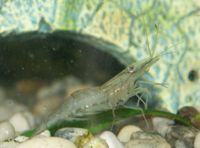Rhino Shrimp (Caridina gracilirostris)
From The Aquarium Wiki
| You can contribute to the Aquarium Wiki by expanding this article. Dont be shy!. |
Rhino Shrimp
Caridina gracilirostris
19 Litres (5 US G.)
2-4 cm (0.8-1.6")
Freshwater
6.5 - 7.5
22 -27 °C (71.6-80.6°F)
9-15 °d
1:2 M:F
1.5-2 years
Contents
Alternative Names[edit]
- Rhino Shrimp, Red Nose Shrimp, Rudolph Shrimp, Mosquito Shrimp, Redfronted Shrimp, Rocket Shrimp, Needlenose Caridina, Rote Nashorngarnele
Sexing[edit]
- Males have the red nose and are larger than females.
Tank compatibility[edit]
- A peaceful shrimp that will not bother tank inhabitants. Do not keep with larger predatory fish.
Diet[edit]
- These shrimp are scavengers and whilst they are consumers of algae, that is not their main food. They generally prefer fish food to algae, and will only resort to the latter if the former is unavailable.
Feeding regime[edit]
- Supplementary feedings when necessary depending on the algae content and amount of excess fish food in the environment.
Environment Specifics[edit]
- This Shrimp prefers planted aquariums. Slightly soft (GH 6-10dh) water is preferred (if the GH is too low they can't make their carapace). They are extremely sensitive to ammonia, nitrite and an excess of nitrate, and as such should only be added to a cycled tank. A small level of Iodine in the water is probably recommend to help them moult. This can be supplied via normal fish food or via typical health food shop Kelp tablets.
Behaviour[edit]
- This shrimp likes to swim to get about. If you see your shrimps at the surface a lot then this is probably due to lack of oxygen, nitrite poison or high nitrate levels.
- Approximately once a month (depending on diet, age, and environmental factors), the shrimp will moult. During this time, the shrimp will seek out a place to hide while its new shell hardens, for safety reasons. Many inexperienced aquarists jump to conclusions, assuming their unseen shrimp to have been eaten; these fears are short lived however, as they usually reappear after a few days.
Breeding[edit]
- To breed these shrimp, salt water conditions are required for their fry as well as special feeding. Breeding of this species is considered fairly difficult.
Pictures[edit]
External links[edit]
- PodvodoyAquatics.com - USA Seller
- PetShrimp
- Shrimp Now
- Taxonomic Hierarchy
Commercial Sellers[edit]
- The Shrimp Spot - Worldwide Seller of Freshwater Shrimp
